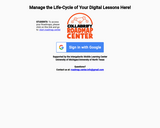
Students will learn about open and closed circuits
- Subject:
- Physical Science
- Material Type:
- Activity/Lab
- Assessment
- Author:
- Elliot Soloway
- Date Added:
- 02/12/2019

Students will learn about open and closed circuits
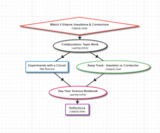
This Roadmap is for Day 2 of the Circuits Unit
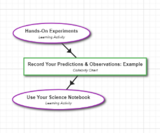
Day 3 of the Circuits Unit for Grade 4
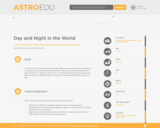
This activity allows pupils to learn the difference between diurnal and nocturnal animals, understand that when it is day here, it is night on the other side of the world, and that it is light when the Sun comes up and it is dark when the Sun goes down. At the end, pupils build a model of the Earth and can experiment with day and night.
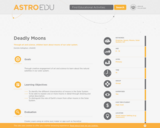
From Earth’s moon to Europa, our solar system is filled with interesting set of natural satellites. Through art and science, children learn about moons of our solar system with the Deadly Moons activity.
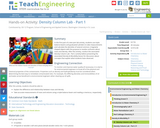
In this first part of a two-part lab activity, students use triple balance beams and graduated cylinders to take measurements and calculate the densities of several common, irregularly shaped objects with the purpose to resolve confusion about mass and density. After this activity, conduct the associated Density Column Lab - Part 2 activity before presenting the associated Density & Miscibility lesson for discussion about concepts that explain what students have observed.

Concluding a two-part lab activity, students use triple balance beams and graduated cylinders to take measurements and calculate densities of several household liquids and compare them to the densities of irregularly shaped objects (as determined in Part 1). Then they create density columns with the three liquids and four solid items to test their calculations and predictions of the different densities. Once their density columns are complete, students determine the effect of adding detergent to the columns. After this activity, present the associated Density & Miscibility lesson for a discussion about why the column layers do not mix.
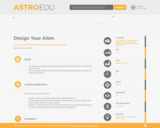
Review the environmental factors that make the Earth habitable and compare them to other worlds within our Solar System. Use creative thinking to design an alien life form suited for specific environmental conditions on an extra-terrestrial world within our Solar System.
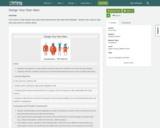
A fun lesson to help students learn about what characteristics that make Earth habitable. Students also create an alien that could survive on another planet.
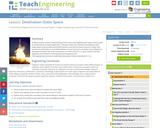
Students acquire a basic understanding of the science and engineering of space travel as well as a brief history of space exploration. They learn about the scientists and engineers who made space travel possible and briefly examine some famous space missions. Finally, they learn the basics of rocket science (Newton's third law of motion), the main components of rockets and the U.S. space shuttle, and how engineers are involved in creating and launching spacecraft.
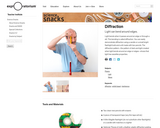
In this optics activity, demonstrate diffraction using a candle or a small bright flashlight bulb and a slide made with two pencils. Learners will observe the diffraction pattern and learn that light has wavelike properties.

This activity from the Exploratorium provides an introduction to the diffraction of light which indicates its wavelike properties. Two pencils are used to create a slit through which a flashlight bulb or candle˘ďď_s light is examined. The site contains an explanation of the observed interference patterns, additional materials that can be experimented with, and an extension activity. This activity is part of Exploratorium's Science Snacks series.
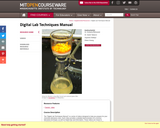
The "Digital Lab Techniques Manual" is a series of videos designed to help you prepare for your chemistry laboratory class. Each video provides a detailed demonstration of a common laboratory technique, as well as helpful tips and information. These videos are meant to supplement, and not replace, your lab manual and assigned reading. In fact, you will most benefit from watching the videos if you have already read the appropriate background information. To be a great experimentalist, you must understand both theory and technique! If you have questions about what you see, make sure to ask your TA or your instructor. WARNING NOTICE: The experiments described in these materials are potentially hazardous and require a high level of safety training, special facilities and equipment, and supervision by appropriate individuals. You bear the sole responsibility, liability, and risk for the implementation of such safety procedures and measures. MIT shall have no responsibility, liability, or risk for the content or implementation of any of the material presented.
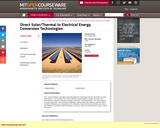
" This course introduces principles and technologies for converting heat into electricity via solid-state devices. The first part of the course discusses thermoelectric energy conversion and thermoelectric materials, thermionic energy conversion, and photovoltaics. The second part of the course discusses solar thermal technologies. Various solar heat collection systems will be reviewed, followed by an introduction to the principles of solar thermophotovoltaics and solar thermoelectrics. Spectral control techniques, which are critical for solar thermal systems, will be discussed."
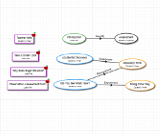
The Discovering Matter lesson allows for students to conduct one of their first experiments in 3rd grade. Through the Roadmap they are introduced to the three common states of matter, the terms constant and variable, as well as being introduced to creating a driving question and creating an experiment (with help). The activities can be completed as a group or as individuals. The choice is yours.

Join Simon, Anita and Dennis as they explore the names of clouds. And what's a Contrail?Download the Clouds Module storybook and learning activities!
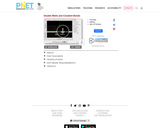
Explore tunneling splitting in double well potentials. This classic problem describes many physical systems, including covalent bonds, Josephson junctions, and two-state systems such as spin 1/2 particles and ammonia molecules.
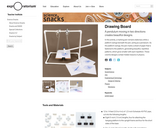
The Drawing Board consists of a marking pen that remains stationary and a platform that swings beneath the pen, acting as a pendulum. As the platform swings, the pen marks a sheet of paper that is fastened to the platform, generating beautiful repetitive patterns. These colorful designs contain hidden lessons in physics. This resource includes instructions for making a large-scale Drawing Board as well.
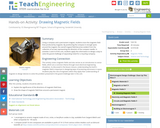
Students use a compass and a permanent magnet to trace the magnetic field lines produced by the magnet. By positioning the compass in enough spots around the magnet, the overall magnet field will be evident from the collection of arrows representing the direction of the compass needle. In activities 3 and 4 of this unit, students will use this information to design a way to solve the grand challenge of separating metal for a recycling company.
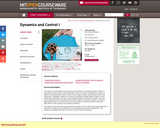
This class is an introduction to the dynamics and vibrations of lumped-parameter models of mechanical systems. Topics include kinematics; force-momentum formulation for systems of particles and rigid bodies in planar motion; work-energy concepts; virtual displacements and virtual work; Lagrange's equations for systems of particles and rigid bodies in planar motion; linearization of equations of motion; linear stability analysis of mechanical systems; free and forced vibration of linear multi-degree of freedom models of mechanical systems; and matrix eigenvalue problems. The class includes an introduction to numerical methods and using MATLABĺ¨ to solve dynamics and vibrations problems.